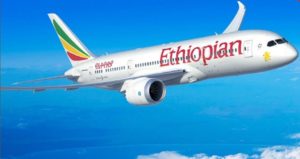
The African Union has announced the establishment of a Single African Air Transport Market, which promises to boost economic growth across the continent and to be boon to carriers like Ethiopian Airlines, Africa’s largest carrier. (Photo: The Chronicle)
The African Union (AU) has reached a major milestone with the inauguration of a Single African Air Transport Market (SAATM), a concept years in the making, which promises to liberalize civil aviation throughout the continent and move Africa toward economic integration.
The announcement of the launch came at the African Union Summit in Addis Ababa, Ethiopia, on January 28.
The International Air transport Association (IATA) welcomed the decision, arguing that increased connectivity across Africa will make the African airline industry more competitive, stimulate demand, and make airline travel more accessible. The association also concludes the SAATM will allow an expansion of tourism, expanded trade and more commerce among African countries and the rest of the world.
The AU says the unified market will result in 300,000 additional direct jobs and 2 million indirect jobs.
“The SAATM has the potential for remarkable transformation that will build prosperity while connecting the African continent. Every open air service arrangement has boosted traffic, lifted economies and created jobs. And we expect no less in Africa on the back of the SAATM agreement. An IATA survey suggest that if just 12 key African countries opened their markets and increased connectivity an extra 155,000 jobs and US $1.3 billion in annual GDP would be created in those countries,” said Raphael Kuuchi, IATA’s vice president for Africa, noting that while it is an important step forward, the benefits of a connected continent will come only through effective implementation by the 23 signatory states and the remaining 32 AU member states yet to commit.
Those 23 nations include Benin, Botswana, Burkina Faso, Cabo Verde, Congo, Cote d’Ivoire, Egypt, Ethiopia, Gabon, Ghana, Guinea, Kenya, Liberia, Mali, Mozambique, Niger, Nigeria, Rwanda, Sierra Leone, South Africa, Swaziland, Togo and Zimbabwe. These nations have a combined population of around 670 million and a combined 2015 GDP of $1.5 trillion, or more than 65 percent of the continent’s GDP. Of the 180 million passengers traveling in Africa in 2015, these nations accounted for more than 56 percent of the passengers handled, 80 percent of intra-African traffic, 54 percent of international visitors to Africa.
“Today’s decision is momentous. SAATM is a decisive step towards greater intra-African connectivity and delivers the framework on which to achieve it. Now it’s time to get down to the work of implementation. Greater connectivity will lead to greater prosperity. Governments must act on their commitments, and allow their economies to fly high on the wings of aviation,” Kuuchi added.
“The Single African Air Transport Market is a welcome step forward in breaking down non-tariff trade and labor movement barriers in Africa, which has been one of the brakes on African development over the years. The idea of greater pan-African cooperation includes lifting of visa restrictions and dropping tariff and customs restraints,” Steve McDonald, Global Fellow and Former Director of the Africa Program at the Woodrow Wilson Center, told Atlanta Black Star.
“While this is a laudable goal on which most African governments agree — as well as outside development specialists — the problem is in implementation. The SAATM idea was first broached in 1999 under the New Partnership for African Development (NEPAD) and was only launched this last week. Many African governments still want to protect their own air spaces, fear dominance by the big airlines like South African, Ethiopian and Kenyan, and want to control revenues in landing and over flight rights. It is instructive that only 23 of 64 African nations have signed on. Certainly a welcome initiative, but only time will tell what impact it will have.”
The AU vision of unified air transport is based on the Yamoussoukro Decision, a multilateral agreement among the AU nations calling for the full liberalization of the skies in Africa and an easing of the barriers allowing for the movement of people, goods and services. Specifically, the AU says the Yamoussoukro Decision calls for “full liberalization in terms of market access between African States, the free exercise of traffic rights, the elimination of restrictions on ownership and the full liberalization of frequencies, fares and capacities.” According to IATA, while African nations account for 16.75 of the world population, they only claim 2 to 4 percent of global passenger traffic. Further, protectionist policies have translated into expensive ticket prices, poor airline cooperation and connectivity, resulting in an impediment to air traffic growth in Africa.
The benefits of SAATM are promising, including 25 percent lower ticket prices, convenience, time saving and more connectivity between AU nations, with more direct and regular flights between African cities, as opposed to flights requiring stopovers in Europe or the Mideast. Opening up these air routes has the potential to boost tourism and the economies of the AU member nations. Implementation of a common airline transportation market comes as African nations have taken steps toward free movement across national borders along the lines of a European Union “seamless borders” model, including a common electronic AU passport, free trade and plans for visa-free travel. While international tourism in Africa more than doubled between 1995 and 2014, Africans were only four in 10 visitors, a testament not only to high cost of air travel but also to lengthy and burdensome visa applications.
80% of airtravel from #Africa to the world is controlled by non-African Airlines. To fix this, today, 23 countries, including #Nigeria, South Africa, #Ethiopia & #Kenya, agreed to a “Single African Air Transport Market”. It’s about time. We have been discussing this for years. pic.twitter.com/Yi6JtMSIHO
— Zemedeneh Negatu (@Zemedeneh) January 29, 2018
With the implementation of a common and competitive aviation market, member states will be able to fly their airlines on any intra-African routes based on economic and financial considerations, the AU notes. Consumer protection regulations provided by the African Civil Aviation Policy (AFCAP) will guarantee basic consumer rights — including a ban on deceptive and discriminatory practices, and compensation for canceled or delayed flights, boarding denials, rerouting and downgrading — and a dispute settlement mechanism including negotiation and arbitration, a board of appeal and an arbitration tribunal.
Member states and their respective civil aviation authorities are responsible for maintaining basic safety and security standards in accordance with International Civil Aviation Organisation (ICAO) recommendations and national laws. The SAATM enjoys the strong support of the African Airlines Association (AFRAA), which accounts for 85 percent of international traffic carried by African airlines, according to the AU.
With the SAATM, the African Union aims for a “safe, secure, efficient, affordable and sustainable air transport industry in Africa.” The promises for increased economic growth and cohesion among African nations are there, but what happens next remains to be seen, as the key is all in the implementation in the coming years, as the AU also plans for a European Union-style Continental Fee Trade Area (CFTA) in late 2018, and possibly an African central bank and single currency within a decade.


